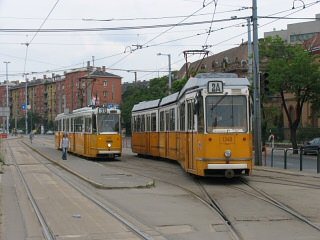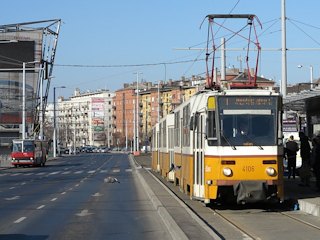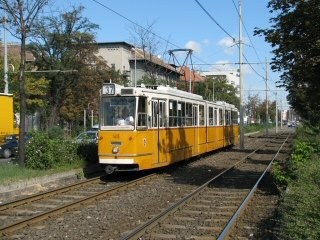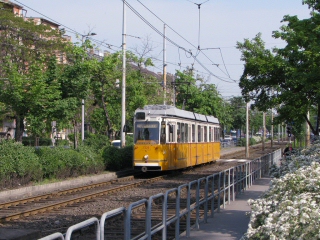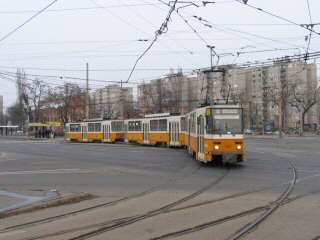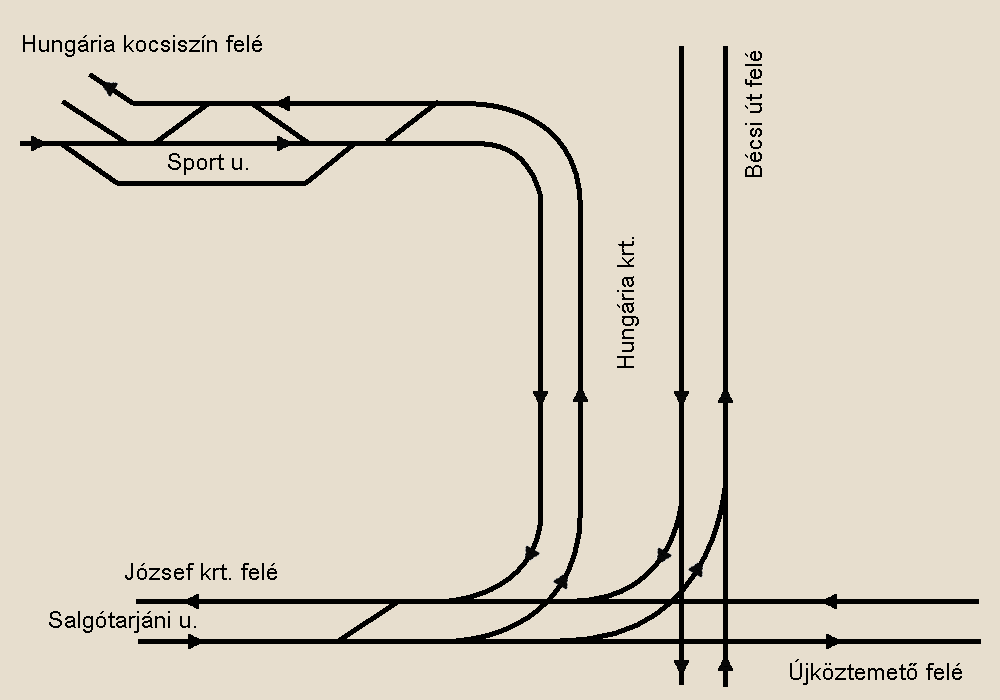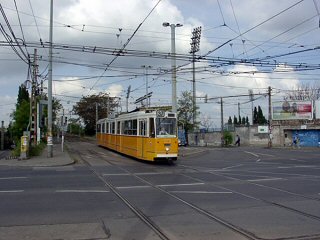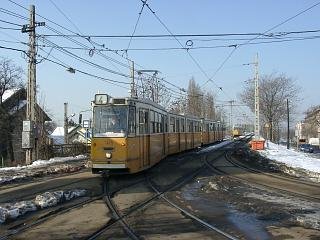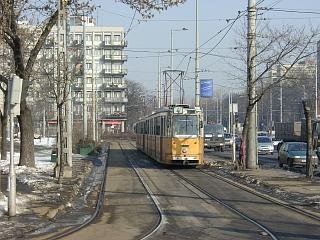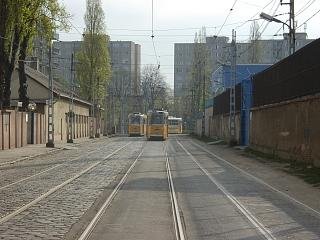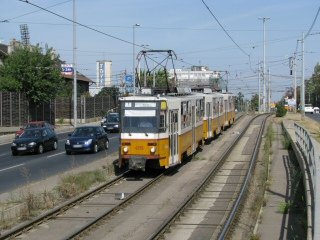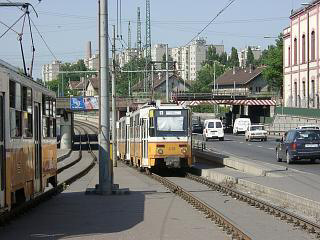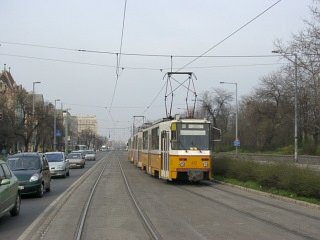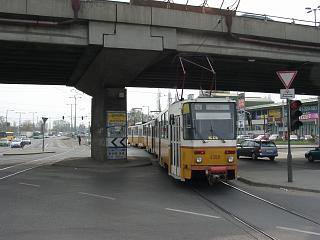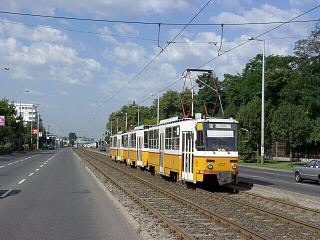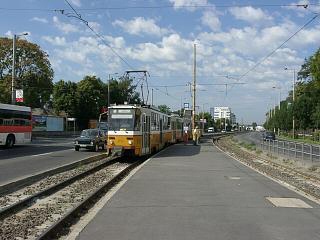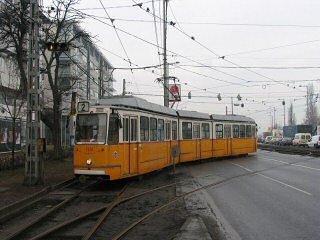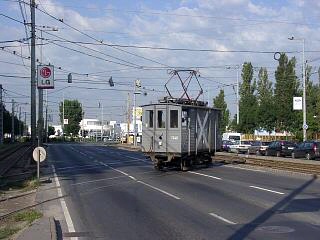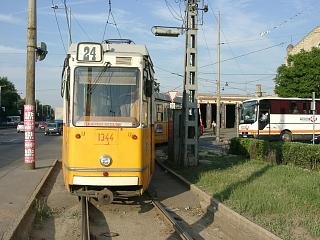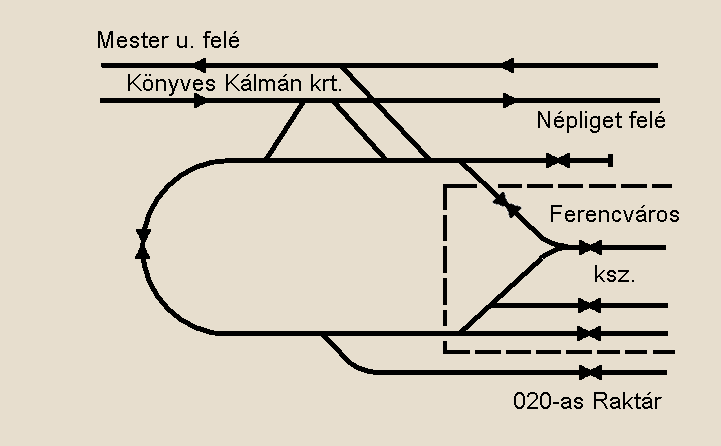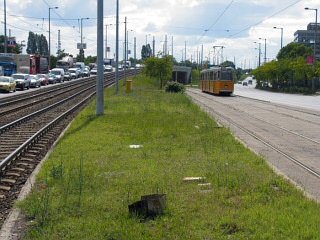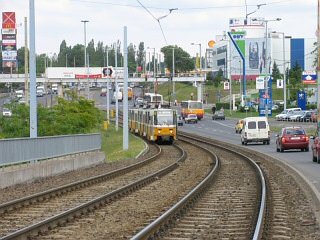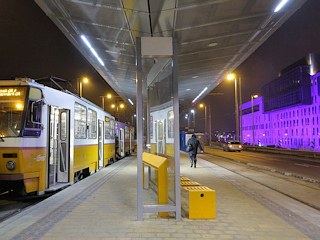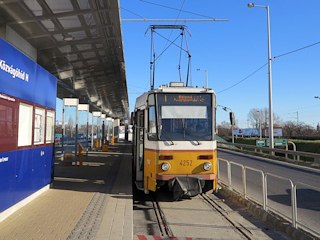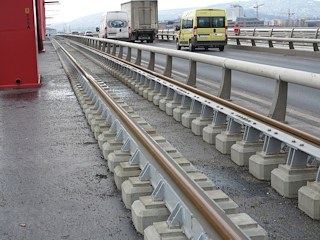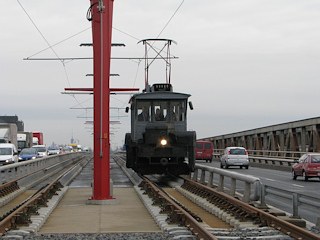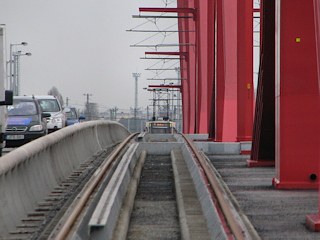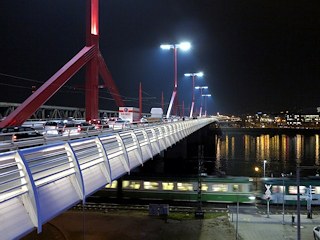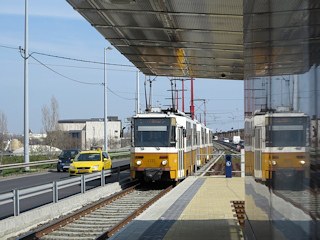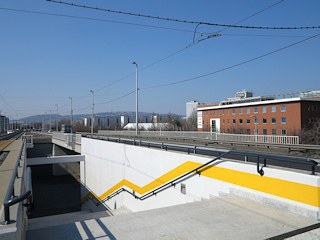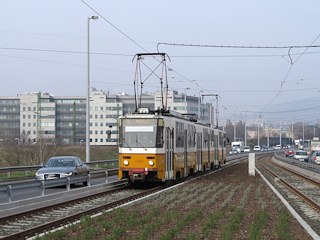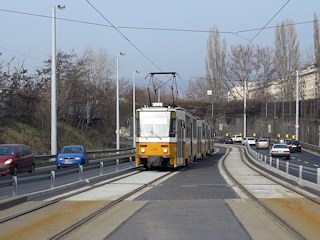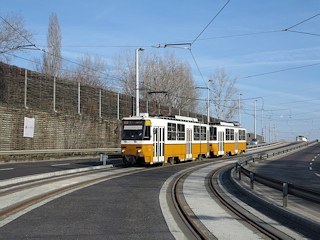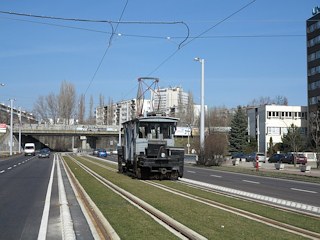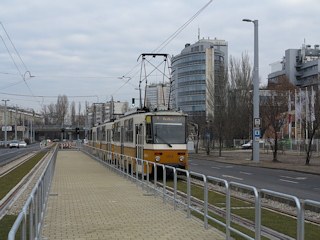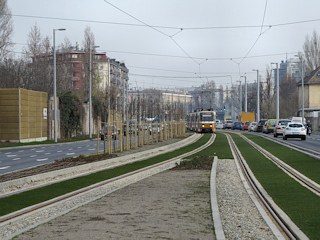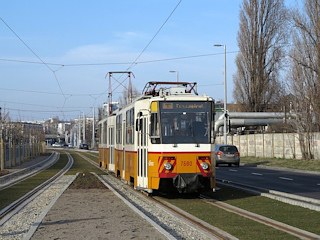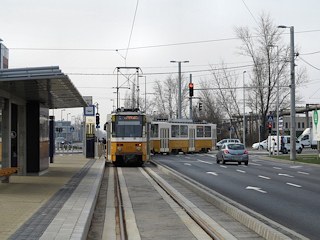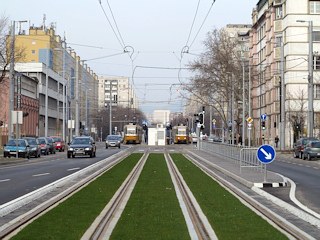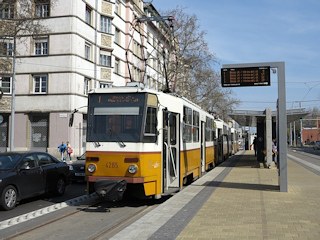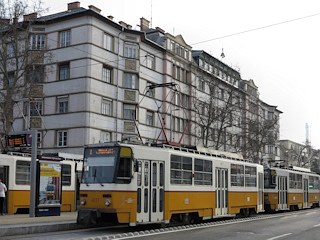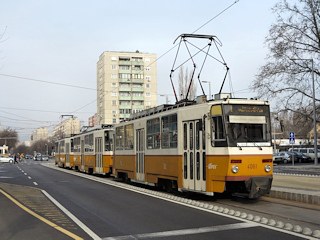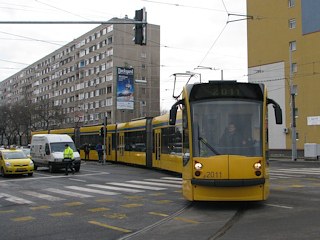Tram-hiker's
guide to Budapest
Latest update: 14. June, 2015
![]()
Puskás Ferenc stadion M (formerly Stadionok)
The stop at Puskás Ferenc stadion has three tracks and multiple crossover possibilities. This is rarely used by normal (scheduled) courses, but trams going from one depot to another often reverse here. For example, on the picture to the left, you can see a tram 37 and 2A - none of these routes runs here normally.
The stadium after which the stop was named - originally called Népstadion ("People's Stadium"), where the rock band Queen gave a memorable (their first one behind the "Iron Curtain") concert in 1986 - is a bit further away.
The trolley bus traffic is not only strong because of the termini here, but also because of the proximity of the trolley bus depot: there are sections of overhead in the neighbouring streets used only by depot-bound vehicles.
From here on the tram is separated from the street, but it's hard to take good photos of it, because of the overhead supports between the tracks. An exception can be found just before reaching Salgótarjáni utca - a scissors crossover used to be here.
The crossing of Hungária körút and Salgótarjáni utca - at the stop Hidegkuti Nándor Stadion - is an exciting place for the fans of electric public transit: there are diverging tracks connecting route 1 to route 37, and these are crossed by the depot route of the trolley buses. A few meters away you'll find two more connecting tracks diverging from route 37: these lead towards Remise Hungária via Sport utca. If you're lucky, you can catch various depot runs between Hungária and the Grand Boulevard, or even trams on test runs, driving school rides, etc.
The four pictures above might give you a hint of what's to see here: the transport of the first Combino on its way to Hungária, a tram 37 on the "wrong side " due to the annual tram drivers' contest, a TW6000 on driving school ride, and a depot-bound Ganz CSMG2 double-set of the Grand Boulevard routes.
This tram depot is the home of the Grand Boulevard services 4 and 6. Until recently this meant lots of Ganz articulated cars, now its more and more Combinos.
-> A pictorial report about Remise Hungária, being rebuilt for the Combinos
After Hidegkuti Nándor Stadion, the tracks start to dive to cross state railway lines via an underpass. The western ramp of this subway (seen on the left-hand-side above, with the transport of the first Combino) is quite easily photographable, although the sun shines from the other direction for most of the day (see photo on the right-hand-side).
From here the ring street is called Könyves Kálmán körút. A bit of history again: Könyves Kálmán was a hungarian king on the turn of the 11th and 12th century, being known for his enlightenedness and education.
But back to trams: just as trams rise from the underpass, their tracks are crossed by tram 28. There are no track connections here at all, but this route can very nicely be photographed, as the two pictures above show (the sun shines from the perfect angle in the evening).
The rest is hard to photograph again. Here the line passes by a slightly neglected large park, known as Népliget (People's Park).
This used to be a popular hang-out place, but became rather disreputable during the last three decades. There's also a football stadium and a coach station here. The tram stop also has one of these large concrete roofs similar to Flórián tér, Szentlélek tér and Közvágóhíd.
The rest of the route runs on segregated tracks again.
Yes, another tram depot along the line! Just like Hungária, this one doesn't operate trams for route 1 either, yet, it's one of the most interesting places: apart from the Ganz CSMG2 and KCSV7 articulated vehicles for routes 2, 2A, 17, 24, 51, 51A, 37 and 37A, this is where the "Muki" freight locos, heritage trams and some special vehicles are housed!
The extra track on the side of the street (photo on the left) can also be full of life sometimes. You can for example catch route 51A (formerly known as 21A, and before that 30A) taking a pause on the stub track between the depot's outer wall and the street (photo on the right).
Mester utca is yet another strange junction. Here the tracks of route 1 (horizontal on the track layout below) go (almost) straight ahead, but there are also diverging tracks turning into Mester utca, used only by depot rides:
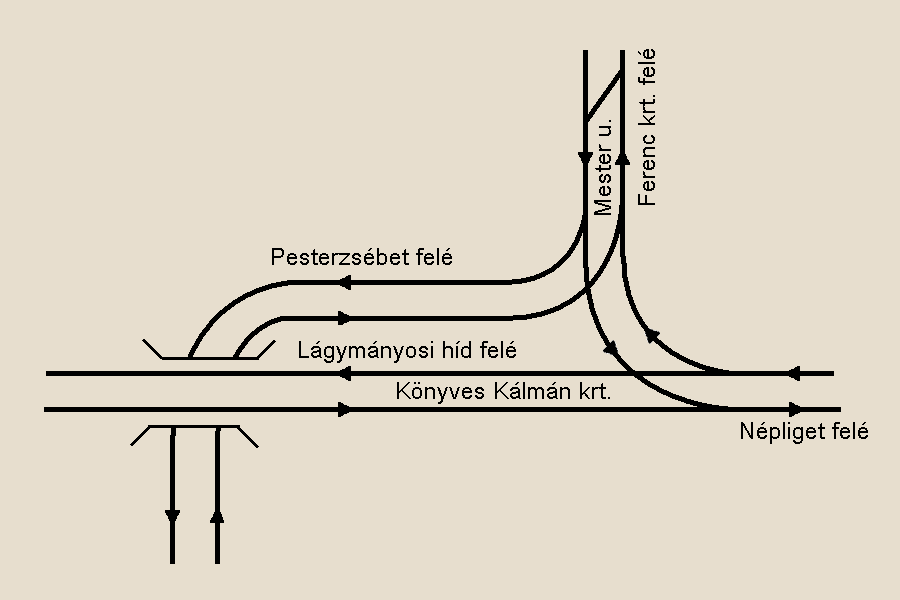
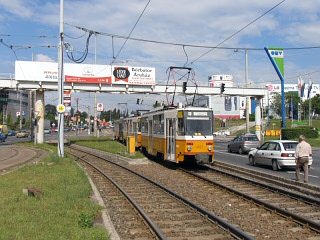
Track layout (C) by Balázs
Fejes, from villamosok.hu
The tracks coming from Mester utca are not connected to route 1, but turn into the other direction.
The latter tracks, used by route 51 run parallel to route 1 for a while, then they dive under and turn south. Meanwhile our tram 1 climbs the ramp, which is part of the bridgehead for Rákóczi híd. After passing over Soroksári út, we reach the former terminus.
From here you can either approach the terminus of tram routes 2 and 24 in Soroksári út via an underpass, or go towards the Danube via another underpass, where the HÉV (suburban railway line) to Csepel is running. The large building in the background of the picture to the left is the Palace of Arts, which is extravagantly illuminated at night-time. Apart from this there isn't much to see here, to be honest.
->
Link to route 2 and 24 at Közvágóhíd
->
Jump over to the Csepel HÉV at Közvágóhíd
Rákóczi híd - called Lágymányosi híd until 2011 - was built between 1992 and 95, with room reserved for tram tracks. Even overhead posts with the design of the bridge were manufactured, and then put into storage, because the municipal authorities blocked the extension of the tram line even after 2000, when route 1 got here.
The tram line was built at last in 2014-15, with the tracks having a strange "bridge on a bridge" construction. I don't particularly like this bridge, but it does look nice at night!
Tram line 1 starts in Buda, goes over to Pest, round the inner city, and then comes back to Buda. The first stop is called Infopark...
... which refers to the IT companies located around here. This is one of the few stops that can only by accessed either by stairs or by elevator, because it sits between car lanes on an embankment.
Budafoki út/Dombóvári út is another "LRT-like" stop, with a crossover near the platform. This isn't really a touristic area of the city, but it's quite good for taking photos of trams :)
The embankment ends here, the tracks dive and take a 90-degrees-turn to reach:
As we return to the city streets we get back the grass-covered tracks I liked so much in Óbuda.
We're two stops away from the terminus: Hauszmann Alajos utca/Szerémi út...
... and after more grass...
... Hengermalom út/Szerémi út. That's where we make another 90-degrees-turn into:
This street takes us right to Kelenföld vasútállomás M, somewhere under that tall white building in the distance...
... but the tram tracks end short of Fehérvári út.
The terminus is just like a normal stop, with a container for waiting booth for drivers, but both tracks are connected to Fehérvári út.
-> Over to the Fehérvári út tram routes
![]()
Back to the
top
Back
to the opening page
Back
to the clickable map
Disclaimer: The author cannot
be held responsible for mistakes, misinterpretations, inaccuracies, inactualities,
etc. on/of these pages, nor for the content of other pages linked in.
![]()
Send
a mail to the author
The
author's homepage
